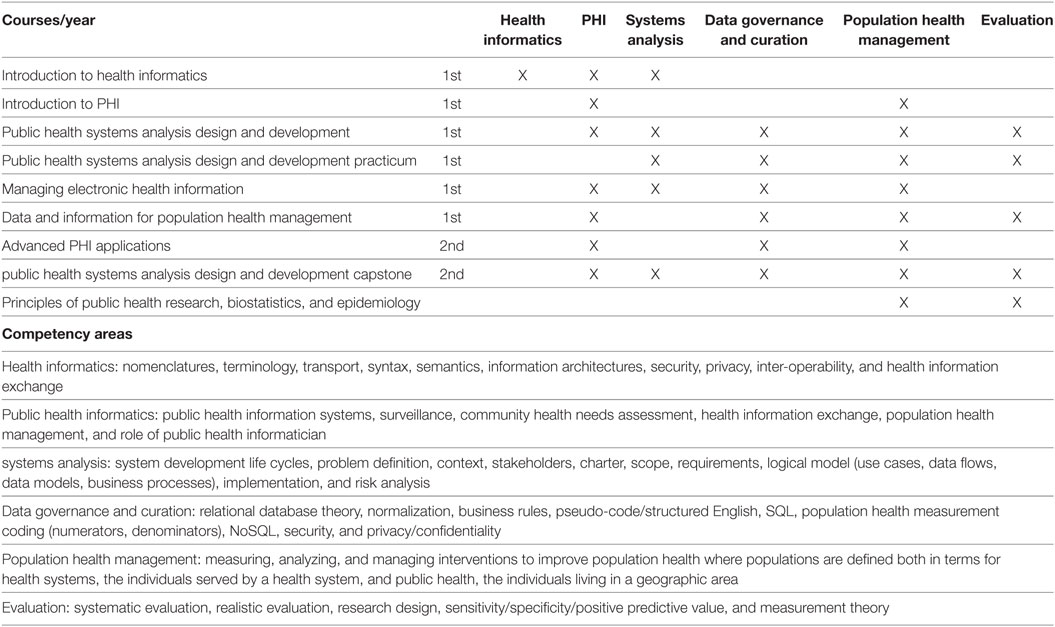Difference between revisions of "Template:Article of the week"
Shawndouglas (talk | contribs) (Updated article of the week text) |
Shawndouglas (talk | contribs) (Updated article of the week text) |
||
| Line 1: | Line 1: | ||
<div style="float: left; margin: 0.5em 0.9em 0.4em 0em;">[[File: | <div style="float: left; margin: 0.5em 0.9em 0.4em 0em;">[[File:Tab4 Wholey FrontPubHealth2019 6.jpg|240px]]</div> | ||
'''"[[Journal: | '''"[[Journal:Developing workforce capacity in public health informatics: Core competencies and curriculum design|Developing workforce capacity in public health informatics: Core competencies and curriculum design]]"''' | ||
We describe a master’s level [[public health informatics]] (PHI) curriculum to support workforce development. Public health decision-making requires intensive [[information management]] to organize responses to health threats and develop effective health education and promotion. PHI competencies prepare the public health workforce to design and implement these information systems. The objective for a master's and certificate in PHI is to prepare public health informaticians with the competencies to work collaboratively with colleagues in public health and other health professions to design and develop information systems that support population health improvement. The PHI competencies are drawn from computer, information, and organizational sciences. A curriculum is proposed to deliver the competencies, and the results of a pilot PHI program are presented. Since the public health workforce needs to use information technology effectively to improve population health, it is essential for public health academic institutions to develop and implement PHI workforce training programs. ('''[[Journal:Developing workforce capacity in public health informatics: Core competencies and curriculum design|Full article...]]''')<br /> | |||
<br /> | <br /> | ||
''Recently featured'': | ''Recently featured'': | ||
: ▪ [[Journal:Assessing cyberbiosecurity vulnerabilities and infrastructure resilience|Assessing cyberbiosecurity vulnerabilities and infrastructure resilience]] | |||
: ▪ [[Journal:What is the meaning of sharing: Informing, being informed or information overload?|What is the meaning of sharing: Informing, being informed or information overload?]] | : ▪ [[Journal:What is the meaning of sharing: Informing, being informed or information overload?|What is the meaning of sharing: Informing, being informed or information overload?]] | ||
: ▪ [[Journal:Cyberbiosecurity: An emerging new discipline to help safeguard the bioeconomy|Cyberbiosecurity: An emerging new discipline to help safeguard the bioeconomy]] | : ▪ [[Journal:Cyberbiosecurity: An emerging new discipline to help safeguard the bioeconomy|Cyberbiosecurity: An emerging new discipline to help safeguard the bioeconomy]] | ||
Revision as of 01:42, 19 June 2019
"Developing workforce capacity in public health informatics: Core competencies and curriculum design"
We describe a master’s level public health informatics (PHI) curriculum to support workforce development. Public health decision-making requires intensive information management to organize responses to health threats and develop effective health education and promotion. PHI competencies prepare the public health workforce to design and implement these information systems. The objective for a master's and certificate in PHI is to prepare public health informaticians with the competencies to work collaboratively with colleagues in public health and other health professions to design and develop information systems that support population health improvement. The PHI competencies are drawn from computer, information, and organizational sciences. A curriculum is proposed to deliver the competencies, and the results of a pilot PHI program are presented. Since the public health workforce needs to use information technology effectively to improve population health, it is essential for public health academic institutions to develop and implement PHI workforce training programs. (Full article...)
Recently featured:










